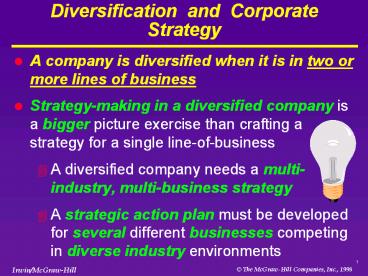Diversification and Corporate Strategy - PowerPoint PPT Presentation
1 / 13
Title:
Diversification and Corporate Strategy
Description:
A company is diversified when it is in two or more lines of business Strategy-making in a diversified company is a bigger picture exercise than crafting a strategy ... – PowerPoint PPT presentation
Number of Views:239
Avg rating:3.0/5.0
Title: Diversification and Corporate Strategy
1
Diversification and Corporate Strategy
- A company is diversified when it is in two or
more lines of business - Strategy-making in a diversified company is a
bigger picture exercise than crafting a strategy
for a single line-of-business - A diversified company needs a multi-industry,
multi-business strategy - A strategic action plan must be developed for
several different businesses competing in diverse
industry environments
2
Stages in Transitioning from a Single Business
to a Diversified Company
- STAGE 1 Small single-business serving a
regional market - STAGE 2 Geographic expansion
- STAGE 3 Vertical integration (optional)
- STAGE 4 Diversification--usually initiated when
growth opportunities dwindle in the companys
present business
3
When to Diversify?
- When it makes sense to diversify depends on
- Growth potential in present business
- Attractiveness of opportunities to transfer
existing competencies to new businesses - Potential cost-saving opportunities to be
realized by entering related businesses - Availability of adequate financial and
organizational resources - Managerial expertise to cope with complexity of
operating a multi-business enterprise
4
When Does DiversificationStart to Make
Sense?
- Strong competitive position, rapid market growth
-- Not a good time to diversify
- Weak competitive position, rapid market growth --
Not a good time to diversify
- Strong competitive position, slow market growth
-- Diversification is top priority consideration
- Weak competitive position, slow market growth --
Diversification merits consideration
5
Corporate Strategy Alternatives
Vertical Integration
Diversify into Related Businesses
Diversify into Unrelated Businesses
Single Business Concentration
Diversify into Related Unrelated Businesses
6
Diversification Strategies
- Entering new industries
- Related diversification
- Unrelated diversification
- Divestiture and liquidation
- Corporate turnaround, retrenchment, and
restructuring - Multinational diversification
7
Strategies for EnteringNew Businesses
Acquire existing company
Start-up new business internally
Joint venture with another company
8
Types of Strategic Fit
Technology Fits
Operating Fits
Distribution Customer-Related Fits
Managerial Fits
9
What Is Unrelated Diversification?
- Involves diversifying into businesses with
- No strategic fit
- No meaningful value chainrelationships
- No unifying strategic theme
- Approach is to venture into any business in
which we think we can make a profit - Firms pursuing unrelated diversification are
often referred to as conglomerates
10
Acquisition Criteria For Unrelated
Diversification Strategies
- Can business meet corporate targets for
profitability and ROI? - Will business require substantial infusions of
capital? - Is business in an industry with growth potential?
- Is business big enough to contribute to the
parent firms bottom line? - Is there potential for union difficulties or
adverse government regulations? - Is industry vulnerable to recession, inflation,
high interest rates, or shifts in government
policy?
11
Attractive Acquisition Targets
- Companies with undervalued assets
- Capital gains may be realized
- Companies in financial distress
- May be purchased at bargain prices and turned
around - Companies with bright
prospects but limited capital
12
Appeal of Unrelated Diversification
- Business risk scattered over different industries
- Capital resources can be directed to those
industries offering best profit prospects - Stability of profits -- Hard times in one
industry may be offset by good times in another
industry - If bargain-priced firms with big profit potential
are bought, shareholder wealth can be enhanced
13
Drawbacks of Unrelated Diversification
- Difficulties of competently managing many diverse
businesses - There are no strategic fits which can be
leveraged into competitive advantage - Consolidated performance of unrelated businesses
tends to be no better than sum of individual
businesses on their own (and it may be worse) - Promise of greater sales-profit stability over
business cycles seldom realized































